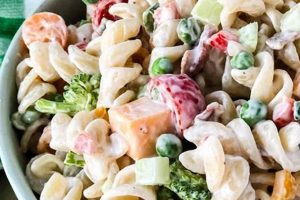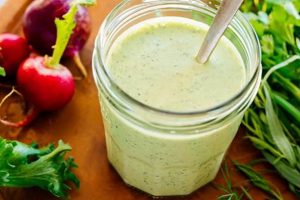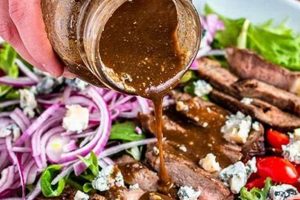A classic culinary emulsion, a blend of olive oil and an acidic element like vinegar or citrus juice, often enhanced with herbs, spices, and other flavoring agents, forms the foundation of many salads. A simple example combines three parts extra virgin olive oil with one part red wine vinegar, a pinch of salt, and freshly ground black pepper.
Such dressings offer a healthy and flavorful way to enhance fresh produce, contributing monounsaturated fats, antioxidants, and vitamins. Their versatility allows for endless customization, adapting to diverse palates and culinary traditions worldwide. From ancient civilizations to modern kitchens, these mixtures have played a crucial role in elevating simple ingredients into satisfying meals.
Further exploration will cover fundamental techniques for creating perfect emulsions, a variety of flavor combinations, and ideal pairings of specific dressings with different types of salads and ingredients.
Tips for Crafting Exceptional Vinaigrettes
Achieving a balanced and flavorful emulsion requires attention to detail and an understanding of fundamental principles. These tips offer guidance for creating dressings that enhance, rather than overpower, the flavors of fresh ingredients.
Tip 1: Quality Ingredients Matter: The foundation of a superb dressing lies in the quality of its components. Opt for extra virgin olive oil with a robust flavor profile and a good quality vinegar, such as red wine, balsamic, or apple cider.
Tip 2: Balance is Key: Strive for a harmonious balance between the oil and acid. A classic 3:1 ratio (oil to vinegar) provides a good starting point, but experimentation is encouraged. Taste and adjust accordingly.
Tip 3: Emulsify Effectively: A proper emulsion prevents the dressing from separating. Whisk vigorously or use a blender to combine the oil and vinegar thoroughly. A touch of Dijon mustard can act as an emulsifier, helping to bind the ingredients together.
Tip 4: Seasoning is Crucial: Salt and freshly ground black pepper are essential. A pinch of sugar can help balance acidity, while a small amount of garlic or shallot adds complexity.
Tip 5: Fresh Herbs Elevate Flavor: Incorporate finely chopped fresh herbs like parsley, chives, oregano, or thyme to enhance the aroma and taste of the dressing.
Tip 6: Experiment with Flavors: Don’t be afraid to experiment with different ingredients. Consider adding lemon zest, minced ginger, honey, or a dash of hot sauce to create unique and flavorful combinations.
Tip 7: Taste and Adjust: Before tossing the salad, taste the dressing and adjust the seasoning as needed. The final flavor should be bright, balanced, and complementary to the other ingredients.
By following these tips, one can elevate simple salads with flavorful, healthful, and visually appealing dressings.
Following these guidelines allows for consistent creation of high-quality vinaigrettes, transforming simple salads into culinary delights.
1. High-quality olive oil
High-quality olive oil forms the foundation of a superior olive oil vinaigrette salad dressing. The oil’s characteristics significantly impact the dressing’s overall flavor, texture, and health benefits. Selecting the right olive oil is paramount for achieving a truly exceptional culinary experience.
- Flavor Profile
High-quality extra virgin olive oil offers a complex flavor profile, ranging from fruity and peppery to grassy and buttery. These nuanced flavors contribute depth and complexity to the vinaigrette, enhancing the taste of the salad ingredients. A Tuscan extra virgin olive oil, for example, with its peppery notes, might pair well with a robust salad featuring kale and grilled vegetables, while a milder, fruitier oil might complement a delicate salad of spring greens and berries. The flavor profile of the oil directly influences the final taste of the dressing.
- Acidity Level
Extra virgin olive oils with lower acidity levels are generally considered higher quality. Lower acidity contributes to a smoother, less pungent flavor in the vinaigrette. This is particularly important in dressings where the delicate flavors of fresh herbs or vegetables are showcased. High acidity can overpower these subtle flavors, whereas a low-acidity oil allows them to shine.
- Antioxidant Content
High-quality extra virgin olive oils are rich in antioxidants, beneficial compounds that contribute to numerous health benefits. These antioxidants are preserved in the vinaigrette, adding nutritional value to the salad. Choosing an oil with a high antioxidant content elevates the dressing beyond mere flavor enhancement, transforming it into a healthful addition to the meal.
- Production Methods
The production method significantly influences the quality of olive oil. Oils produced through cold-pressing, a mechanical process that avoids heat and chemicals, retain more of their natural flavors and beneficial compounds. Understanding the production method helps consumers select oils that contribute to a superior vinaigrette, both in terms of taste and health benefits. For instance, oils extracted using solvents or high heat can have a negative impact on the final flavor of the dressing.
Careful selection of high-quality olive oil elevates the olive oil vinaigrette salad dressing from a simple condiment to a key component of a delicious and healthful meal. The oils distinct characteristics contribute significantly to the final flavor, texture, and nutritional value of the dressing, underscoring the importance of choosing wisely.
2. Acidity (vinegar/citrus)
Acidity plays a crucial role in olive oil vinaigrette salad dressings, providing the necessary balance to the richness of the olive oil. This acidic component, typically vinegar or citrus juice, not only contributes a bright, tangy flavor but also performs several essential functions. The interaction between the acid and the oil creates an emulsion, a temporary binding of the two otherwise immiscible liquids. This emulsification gives the dressing a smooth, creamy texture and prevents it from separating into layers of oil and vinegar. Furthermore, the acidity helps to tenderize leafy greens and other salad ingredients, enhancing their palatability. For example, a vinaigrette made with red wine vinegar will offer a more robust, complex flavor profile compared to one made with a lighter white wine vinegar or lemon juice. The choice of acid significantly influences the overall taste and texture of the dressing.
Specific examples illustrate the importance of acid selection. A balsamic vinaigrette, featuring the rich, sweet acidity of balsamic vinegar, pairs well with roasted vegetables and stronger cheeses. A lemon vinaigrette, with its bright, citrusy notes, complements delicate seafood salads. The acidity level also affects the dressing’s overall balance. Too much acid can create a harsh, overpowering flavor, while too little can result in a bland, oily dressing. Achieving the right balance is key to a successful vinaigrette. This balance can be further refined by considering the other ingredients in the salad. A salad with acidic tomatoes, for example, might benefit from a slightly less acidic dressing, whereas a salad with mild cucumbers might require a more pronounced acidity.
Understanding the function and impact of acidity in olive oil vinaigrette salad dressings allows for greater control over the final product. Careful selection of the acidic component, consideration of its intensity, and attention to overall balance are essential for creating a dressing that complements and enhances the flavors of the salad. The interplay between acidity, oil, and other ingredients ultimately determines the success of the vinaigrette, transforming a simple mixture into a complex and flavorful culinary element.
3. Emulsification technique
Emulsification is crucial for creating a stable and homogenous olive oil vinaigrette salad dressing. It involves dispersing tiny droplets of one liquid (the dispersed phase, in this case, oil) within another liquid (the continuous phase, vinegar or citrus juice) that would normally not mix. This process prevents the dressing from separating into distinct oil and vinegar layers, ensuring a consistent flavor and texture throughout the salad. The stability of this emulsion directly impacts the sensory experience of the vinaigrette.
Several techniques achieve emulsification in vinaigrettes. Whisking vigorously by hand creates shear forces that break down the oil into smaller droplets, allowing them to disperse within the vinegar. A blender or food processor accomplishes this more efficiently, creating a finer, more stable emulsion. Adding emulsifying agents, such as Dijon mustard or egg yolk (for richer dressings), further enhances stability. These agents contain molecules with both hydrophilic (water-loving) and lipophilic (oil-loving) properties, which help to bridge the gap between the oil and vinegar, creating a more permanent bond. For example, a classic French vinaigrette often incorporates a small amount of Dijon, its lecithin acting as a natural emulsifier.
Understanding emulsification is essential for controlling the texture and stability of a vinaigrette. A properly emulsified dressing clings evenly to salad ingredients, delivering consistent flavor in each bite. Furthermore, the size of the dispersed oil droplets influences the dressing’s mouthfeel. Smaller droplets create a smoother, creamier texture, while larger droplets result in a more coarse texture. Practical application of these principles enables the creation of vinaigrettes tailored to specific salads and preferences. Challenges arise when the emulsion breaks, leading to separation. Factors like temperature fluctuations or excessive acidity can destabilize the emulsion. Recognizing these factors allows for proactive measures, such as adjusting ingredient proportions or using more effective emulsifying agents, ensuring a consistently high-quality vinaigrette.
4. Seasoning and flavorings
Seasoning and flavorings constitute critical components of olive oil vinaigrette salad dressings, elevating them beyond simple mixtures of oil and acid. Salt, a fundamental seasoning, not only enhances the inherent flavors of other ingredients but also plays a crucial role in the emulsification process by influencing surface tension between the oil and aqueous phases. Pepper, another foundational element, adds complexity and subtle heat. The interplay between salt and pepper provides a baseline upon which other flavors can be built. For example, a classic vinaigrette often starts with salt, pepper, and a touch of Dijon mustard, the mustard contributing both flavor and emulsification properties.
Beyond these foundational seasonings, a wide array of flavorings contributes depth and nuance to vinaigrettes. Fresh herbs, such as chives, parsley, oregano, or thyme, introduce aromatic complexity. Garlic and shallots impart pungent notes. Sweeteners, like honey or maple syrup, balance acidity and add subtle sweetness. Spices, including cumin, coriander, or paprika, introduce distinct flavor profiles. These flavorings interact synergistically with the base ingredients, creating a harmonious blend. For instance, a vinaigrette featuring lemon juice, oregano, and garlic creates a bright, Mediterranean-inspired profile suitable for Greek salads. Alternatively, a combination of lime juice, cilantro, and chili flakes yields a vibrant, zesty dressing appropriate for Southwestern-style salads. The choice of flavorings depends on the desired outcome and the other salad components.
Careful consideration of seasoning and flavorings is essential for achieving a balanced and flavorful vinaigrette. Over-seasoning can mask the delicate flavors of fresh produce, while under-seasoning can result in a bland, uninspired dressing. The interplay of flavors, the balance of sweet, salty, acidic, and savory notes, and the aromatic contributions of herbs and spices contribute to the overall sensory experience. Understanding these interactions allows for precise control over the final product, transforming a simple vinaigrette into a complex and nuanced culinary creation. Challenges arise when combining disparate flavor profiles. Balancing competing flavors requires careful experimentation and attention to detail, ensuring harmonious integration rather than discordant clashes. Mastering the art of seasoning and flavoring unlocks the full potential of olive oil vinaigrette salad dressings, elevating them from mere condiments to integral components of a well-composed salad.
5. Ingredient Proportions
Ingredient proportions dictate the final character of an olive oil vinaigrette salad dressing. The ratio of oil to vinegar determines the dressing’s overall balance, influencing its taste, texture, and how it interacts with salad ingredients. A classic 3:1 ratio of oil to vinegar produces a balanced vinaigrette, offering a pleasant tartness without being overly acidic. This ratio provides a foundation upon which further flavor complexities can be built. However, adjusting this ratio allows for customization based on personal preference or the specific salad components. A higher proportion of oil creates a richer, milder dressing, while a higher proportion of vinegar yields a sharper, more acidic result. For example, a delicate salad of butter lettuce and fresh herbs might benefit from a 4:1 ratio, emphasizing the subtle flavors of the greens, whereas a robust salad featuring kale and roasted vegetables might pair well with a 2:1 ratio, providing a more assertive counterpoint to the hearty ingredients.
Understanding the impact of ingredient proportions extends beyond the oil and vinegar base. The amount of added seasonings, flavorings, and emulsifiers also plays a crucial role. Too much Dijon mustard, while aiding emulsification, can overpower the other flavors. An excessive amount of honey can create an overly sweet dressing. Similarly, an overabundance of garlic or shallots can result in a pungent, unbalanced vinaigrette. Careful measurement and thoughtful consideration of each ingredient’s contribution are essential for achieving the desired outcome. Practical application involves tasting and adjusting throughout the preparation process. A small adjustment in the amount of salt, pepper, or a specific herb can significantly impact the final flavor profile. This iterative process allows for fine-tuning and ensures a balanced and harmonious dressing.
Mastery of ingredient proportions is essential for crafting successful olive oil vinaigrette salad dressings. A thorough understanding of how each ingredient contributes to the final product, coupled with careful measurement and a willingness to experiment, empowers one to create vinaigrettes tailored to specific needs and preferences. Challenges arise when scaling recipes up or down. Maintaining consistent flavor profiles requires careful recalculation of ingredient quantities to preserve the intended balance. This attention to detail ensures that the vinaigrette remains a harmonious complement to the salad, regardless of the quantity prepared.
Frequently Asked Questions
The following addresses common inquiries regarding the creation and utilization of olive oil-based vinaigrette salad dressings.
Question 1: What is the ideal ratio of olive oil to vinegar in a vinaigrette?
While a 3:1 ratio serves as a standard starting point, optimal proportions depend on the desired flavor profile and the specific types of oil and vinegar used. Experimentation is encouraged to achieve individual preferences.
Question 2: How can one prevent vinaigrette from separating?
Vigorous whisking or blending creates a temporary emulsion. Incorporating an emulsifying agent, such as Dijon mustard or honey, enhances stability and helps maintain a homogenous mixture.
Question 3: What types of vinegar are best suited for vinaigrettes?
A variety of vinegars, including red wine vinegar, balsamic vinegar, white wine vinegar, apple cider vinegar, and champagne vinegar, contribute distinct flavor profiles. Selection depends on the desired taste and the other salad ingredients.
Question 4: Can citrus juice be used in place of vinegar?
Citrus juices, such as lemon, lime, or orange juice, offer a bright, acidic alternative to vinegar. They impart distinct flavor characteristics and are particularly suitable for lighter salads.
Question 5: How long can vinaigrette be stored?
Properly stored in an airtight container in the refrigerator, vinaigrette can typically be stored for up to one week. Separation may occur, requiring re-emulsification before use.
Question 6: Beyond basic seasonings, what other ingredients can enhance a vinaigrette?
Fresh herbs, minced garlic or shallots, spices, sweeteners, and even small amounts of fruit purees or preserves can add complexity and depth of flavor to vinaigrettes.
Careful consideration of ingredients, proportions, and techniques ensures the creation of flavorful and well-balanced vinaigrettes suited to a wide range of salads and palates.
The subsequent section will explore a variety of specific olive oil vinaigrette recipes, showcasing the versatility and adaptability of this classic culinary emulsion.
Olive Oil Vinaigrette Salad Dressing Recipe
Exploration of the fundamental components of an olive oil vinaigrette salad dressing recipe reveals the interplay of quality ingredients, balanced proportions, and proper techniques. From the selection of extra virgin olive oil to the nuanced integration of acidity, seasonings, and flavorings, each element contributes to the final character of this versatile culinary emulsion. Emulsification techniques, crucial for achieving a stable and homogenous mixture, further enhance the sensory experience. Understanding the impact of ingredient ratios, from the oil-to-vinegar balance to the judicious use of herbs and spices, empowers culinary practitioners to craft dressings tailored to specific preferences and salad compositions.
Mastery of the olive oil vinaigrette salad dressing recipe offers a pathway to transforming simple salads into culinary masterpieces. Continued exploration of flavor profiles, ingredient combinations, and innovative techniques promises further evolution of this time-honored culinary staple, ensuring its enduring presence in kitchens worldwide.






